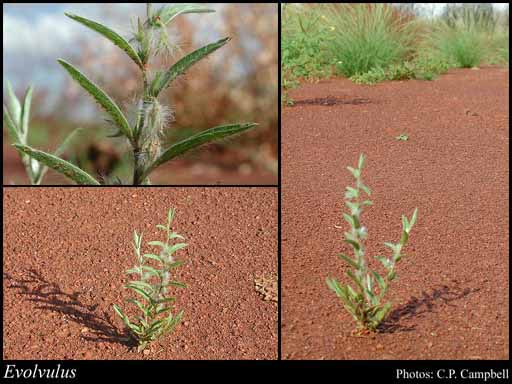- Reference
- Sp.Pl. [Linnaeus] p391 (1763)
- Name Status
- Current







Scientific Description
Family Convolvulaceae.
Habit and leaf form. Herbs, or shrubs (subshrubs); laticiferous, or non-laticiferous and without coloured juice. Autotrophic. Herbs perennial; plants with neither basal nor terminal concentrations of leaves. Trailing or self supporting. Helophytic, mesophytic, and xerophytic. Leaves alternate; spiral; petiolate to sessile; non-sheathing; simple. Leaf blades entire; pinnately veined, or palmately veined; cross-venulate; cordate, or hastate, or sagittate. Leaves without stipules; without a persistent basal meristem. Leaf anatomy. Hairs present (hairs bifid). Stem anatomy. Nodes unilacunar. Secondary thickening anomalous, or developing from a conventional cambial ring; via concentric cambia, or from a single cambial ring.
Reproductive type, pollination. Fertile flowers hermaphrodite. Unisexual flowers absent. Plants hermaphrodite.
Inflorescence and flower features. Flowers solitary, or aggregated in ‘inflorescences’; in cymes. The terminal inflorescence unit cymose. Inflorescences axillary; with involucral bracts, or without involucral bracts. Flowers pedicellate; bracteate; bi- bracteolate. Bracteoles between peduncle and pedicel. Flowers small to medium-sized; regular; 5 merous; cyclic; tetracyclic. Free hypanthium absent. Hypogynous disk present; annular. Perianth with distinct calyx and corolla; 10; 2 -whorled; isomerous. Calyx 5; 1 -whorled; polysepalous; hairy; imbricate; persistent; with the median member posterior. Corolla 5; 1 -whorled; gamopetalous; lobed, or entire. Corolla lobes markedly shorter than the tube. Corolla funnel-shaped to rotate; regular; hairy abaxially (pilose on mid-petaline bands); usually blue. Androecium 5. Androecial members adnate (to the corolla); all equal; free of one another; 1 -whorled. Androecium exclusively of fertile stamens. Stamens 5. Staminal insertion near the base of the corolla tube. Stamens becoming exserted; oppositisepalous. Filaments glabrous. Anthers dehiscing via longitudinal slits; introrse; tetrasporangiate. Pollen grains psilate. Gynoecium 2 carpelled. The pistil 2 celled. Gynoecium syncarpous; synovarious; superior. Ovary plurilocular; 2 locular. Gynoecium median. Styles 2; free; forked; apical. Stigmas 4; 1 - lobed; dry type; papillate; Group II type. Placentation basal. Ovules 2 per locule; ascending; apotropous; non-arillate; anatropous.
Fruit and seed features. Fruit non-fleshy; not hairy; dehiscent; a capsule. Capsules loculicidal (via 4 valves). Fruit usually 4 seeded. Seeds elliptic in outline and more or less trigonous; endospermic. Endosperm oily. Seeds not conspicuously hairy. Cotyledons 2. Embryo chlorophyllous; straight, or curved. Seedling. Germination phanerocotylar.
Physiology, biochemistry. Aluminium accumulation not found. Photosynthetic pathway: C3.
Geography, cytology, number of species. Native of Australia. Not endemic to Australia. Australian states and territories: Western Australia, South Australia, Northern Territory, Queensland, and New South Wales. Northern Botanical Province and Eremaean Botanical Province.
Additional characters Stigmas the stigmatic area linear.
Taxonomic Literature
- Wheeler, J. R.; Rye, B. L.; Koch, B. L.; Wilson, A. J. G.; Western Australian Herbarium 1992. Flora of the Kimberley region. Western Australian Herbarium.. Como, W.A..